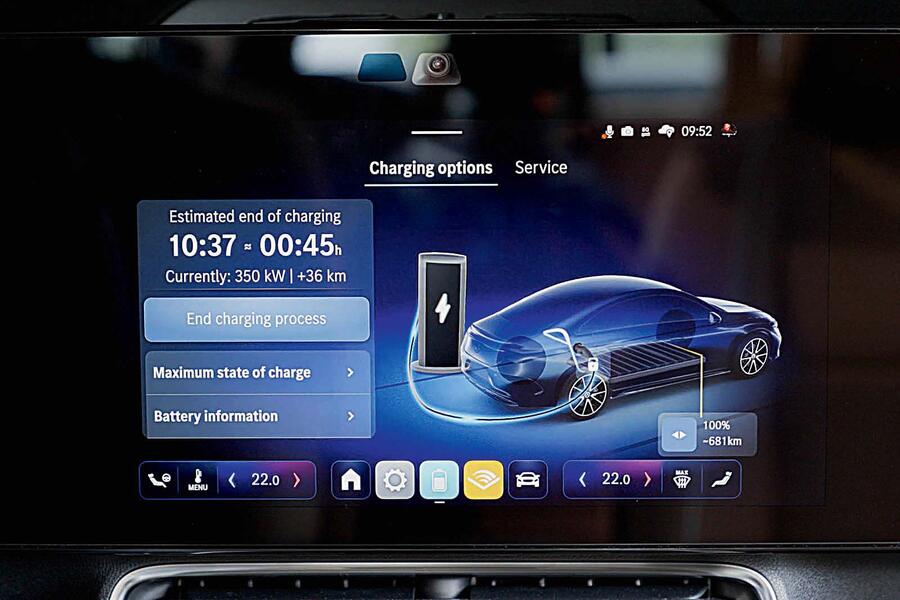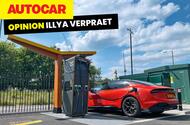Wouldn’t it be better if electric cars were more efficient rather than installing faster chargers?
How long does it take to fill up a car? When the difference between a fast fuel pump and a slow one and a big tank and a small one is three minutes, the answer is ‘who cares?’.
That said, I still find filling up with fuel quite tedious, largely because you have to stand there looking at your money ticking away for the whole duration.
Even so, the question is more pertinent with EVs, which is why, since 2022, our road tests of electric cars have included a rapid-charging test, where we measure how many kilowatts an EV can pull at increments of 10% state of charge.
In recent years, we’ve seen rapid increases in the speeds that both cars and chargers can reach. Our 2019 road test of the Audi E-tron complained that its 150kW peak charging speed was effectively pointless because such chargers hardly existed in the UK. Today, 150kW is about the lowest we would expect from a new EV or a newly installed rapid charger.
But the truth is that actually the answer is still ‘we’re not sure’. When we do these charging tests, we often use the charger at MIRA, which is well-maintained and tends not to be busy and therefore reliably puts out its maximum 300kW if the car can take it. If we use an external one, it will be at a site that we know from experience is reliable and at a time when it’s not very busy.
And there lies the problem: if you rock up at a site with eight 350kW chargers but there are a couple of Porsche Taycans hogging all the juice, the chance that you will get the advertised speed is slim, because it’s unlikely there are enough amps coming from the grid to feed 8x350kW. Chargers are good enough nowadays that you will probably be able to plug in and get a reasonable 100kW, which will suffice in most cases.
But it does call into question the sense of the sky-high speeds that some recently announced cars can allegedly reach. The Lotus Emeya will do 420kW, but I had to drive to Birmingham to find a suitable charger – one promising 400kW. (That’s not a slight on Birmingham, by the way; I just have little cause to go there otherwise). The facelifted Xpeng G6 will allegedly do 451kW.

Future-proofing cars is no bad thing, but I wonder if the ultra-fast chargers to feed them will really get built, and if they are, whether they will be able to give their best consistently. We can complain about the government and that “the infrastructure isn’t good enough”, but I think that’s missing the point.
Let’s be honest: 400kW is an enormous amount of power. Put a different way, it’s about the same as a BMW M3 CS at full throttle (543bhp is 405kW). Surely what we need – to put it in fuel terms – is not faster pumps but smaller tanks that go the same distance.
Even if someone comes up with a production-ready 200kWh solid-state battery tomorrow that weighs 100kg and can charge at 1000kW, that power still needs to come from somewhere.
It’s why I went a bit gooey in my recent review of the Mercedes-Benz CLA EQ. It gets about 100 miles more range than the BMW i4 from a similarly sized battery. That’s 100 miles you don’t have to sit around waiting for it to charge; 100 miles you effectively don’t have to pay for. It’s why I get annoyed at cars that do a wasteful 2.5mpkWh.
It feels faintly coal-powered. When a Ford Mustang V8 does 20mpg, at least you get both speed and burbly noises in return. In an inefficient 600bhp EV, you just get speed.
The other point here is that waiting around for your car to charge is not how it’s supposed to work most of the time. Electricity is already everywhere and in every house, so why aren’t more people able to refill a car while they sleep?
This is where the government should come in. Like many people, I currently live in a rented terraced house. I’m almost guaranteed a parking space right in front, so with a proper 7kW charger and some sort of method for a cable to clear the pavement (such solutions do exist; one is called – you will never guess – ChargeArm), I could easily charge a car at home.
However, there is no incentive to invest in installing one. Realistically, it wouldn’t entitle my landlord to charge more rent and it would become a waste of my money when I move. It’s a similar story with allocated parking and flats.
Such incentives need to come from the government and would be much more helpful in boosting EV uptake than ploughing a load of money into grants – or indeed fast chargers.
Source: Autocar
